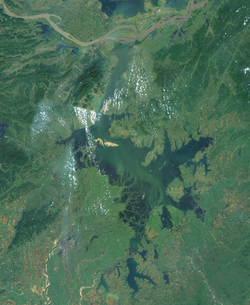Boyang Lake
| Poyang Lake | |
|---|---|

Satellite image of Lake Poyang
|
|
| Location | Jiangxi, China |
| Coordinates | 29°05′N 116°17′E / 29.083°N 116.283°ECoordinates: 29°05′N 116°17′E / 29.083°N 116.283°E |
| Primary inflows | 5 Rivers, primarily the Gan and Xiu |
| Catchment area | 162,225 square kilometres (62,635 sq mi) |
| Basin countries | China |
| Max. length | 170 kilometres (110 mi) |
| Max. width | 17 kilometres (11 mi) |
| Surface area | 3,210 square kilometres (1,240 sq mi) |
| Average depth | 8.4 metres (28 ft) |
| Max. depth | 25.1 metres (82 ft) |
| Water volume | 25.2 cubic kilometres (6.0 cu mi) |
| Residence time | 0.173 years |
| Shore length1 | 1,200 kilometres (750 mi) |
| Surface elevation | 16.5 metres (54 ft) |
| 1 Shore length is not a well-defined measure. | |
Poyang Lake (Chinese: 鄱阳湖/鄱陽湖; pinyin: Póyáng Hú, Gan: Po-yong U), located in Jiangxi Province, is the largest freshwater lake in China.
The lake is fed by the Gan, Xin, and Xiu rivers, which connect to the Yangtze through a channel.
The area of Poyang Lake fluctuates dramatically between the wet and dry seasons, but in recent years the size of the lake has been decreasing overall. In a normal year the area of the lake averages 3,500 square kilometres (1,400 sq mi). In early 2012, due to drought, sand quarrying, and the practice of storing water at the Three Gorges Dam the area of the lake reached a low of about 200 square kilometres (77 sq mi). The lake provides a habitat for half a million migratory birds and is a favorite destination for birding.
During the winter, the lake becomes home to a large number of migrating Siberian cranes, up to 90% of which spend the winter there.
Poyang Lake has also been called Pengli Marsh (彭蠡澤) historically, but they are not the same. Before the Han Dynasty, the Yangtze followed a more northerly course through what is now Longgan Lake whilst Pengli Marsh formed the lower reaches of the Gan River. The area that is now Poyang Lake was a plain along the Gan River. Around 400 AD, the Yangtze River switched to a more southerly course, causing the Gan River to back up and form Lake Poyang. The backing up of the Gan River drowned Poyang County and Haihun County, forcing a mass migration to Wucheng Township in what is now Yongxiu County. Wucheng thus became one of the great ancient townships of Jiangxi Province. This migration gave birth to the phrase, "Drowning Haihun County gives rise to Wucheng Township" (Chinese: 淹了海昏縣,出了吳城鎮).
...
Wikipedia
